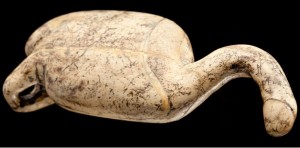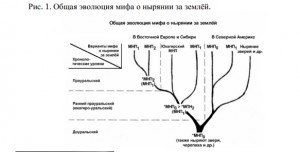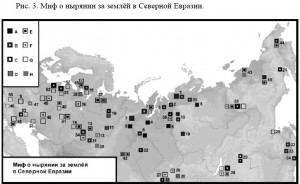Genes and Myths: Ancient Mal’ta DNA and the Earth-Diver Mythological Motif
Earth-Diver is one of the most widely-distributed and well-studied cosmological myths. Found in mostly Uralic-speaking Eastern Europe, in Siberia, in Munda-speaking Northeast India and North America, its action is set in post-diluvial times when a demiurge sends various creatures to bring a piece of mud from the bottom of the ocean. The first creature fails, but the second one succeeds. Importantly, it’s the least likely creature that succeeds, while the more obvious favorite fails. A loon is a much better diver than a duck but it’s the duck that succeeds. In the end, the demiurge blows the earth out of the tiny piece of mud and restores life on it. Depending on the region, the diving creatures are different – in Eurasia it’s waterfowl birds – loon and duck, in North America it’s amphibians such as turtle or frog, animals such as otter or beaver or waterbirds, in Northeast India and the American Southwest – it’s arthropods.
Population folklorists such as Vladimir Napol’skikh (Древнейшие этапы происхождения народов уральской языковой семьи: данные мифологической реконструкции (прауральский космогонический миф)/The Initial Stages of Evolution of Uralic-Speakers: Evidence from a Mythological Reconstruction (Proto-Uralic Cosmogonic Myth). Moscow, 1991) have suggested that the Earth-Diver motif is the folkloric manifestation of a more comprehensive system of beliefs related to the experiences of a shamanic flight in Northern Eurasian and Amerindian cultures. Siberian shamans liken themselves to waterfowl birds flying between worlds in search of the soul of their patient and they manipulate waterfowl figurines during their shamanic seances.
 Remarkably, very similar figurines are found at the 24,000-year-old Mal’ta archaeological site in South Siberia (see one on the left made out of a mammoth tusk), and Napol’skikh, in his 1991 book as well as in a recent talk (see video in Russian, roughly from 11:40 on) proposed that the Mal’ta people possessed the “cult of a waterfowl” and told the Earth-Diver myth. This means that the Earth-Diver motif may go back to pre-LGM times.
Remarkably, very similar figurines are found at the 24,000-year-old Mal’ta archaeological site in South Siberia (see one on the left made out of a mammoth tusk), and Napol’skikh, in his 1991 book as well as in a recent talk (see video in Russian, roughly from 11:40 on) proposed that the Mal’ta people possessed the “cult of a waterfowl” and told the Earth-Diver myth. This means that the Earth-Diver motif may go back to pre-LGM times.
Mal’ta has recently made headlines thanks to the sequencing of the genome of a 4-year-old boy found at this site. The DNA sample fell in-between West Eurasians and Amerindians, without any special connection to East Asians, and showed typical West Eurasian mtDNA and Y-DNA haplogroups, namely U and R, respectively. They are sister lineages of widely distributed in the Americas hg B (mtDNA) and hg Q (Y-DNA). It appears that, in pre-LGM times, Amerindians and West Eurasians formed a genetic continuum and that modern East Asians did not yet emerge as a distinct population.

From: Berezkin, Yuri E. “Полосатый бурундук: Фольклорный мотив в Старом и Новом Свете,” Бестиарий II. Зооморфизмы Азии: движение во времени. St.Petersburg, 2012. С. 7.
This finding may put the distribution of the Earth-Diver myth into a new perspective. Per Davidski’s request, I adduce the map of the distribution of the Earth-Diver motif in Eurasia and North America (see the shaded areas on the left). One should not expect a perfect fit between the distribution of myths and genes but the Earth-Diver distribution is rather clearly demarcated on a worldwide scale and does show continuity between West Eurasia and North America. The motif is notably absent from Western Europe – precisely the area that was covered with the glacier from 25,000 to 14,000 years ago – and from Beringia (Paleoasiatic peoples such as Chukchees and Koryaks as well as Eskimos don’t tell earth-diver stories), which may have been blocked by ice as well. Its presence in the Balkans is a due to relatively recent events such as Turkic and Avar migrations across the southern European steppe.

In this graph, North America is separated from Eastern Europe and Siberia by a dotted line. The root of the tree is MNP-0, which continues unchanged into the American side of the diagram, while the Old World side of the diagram only has MNP-1 and MNP-2. Source: Napol’skikh V.V. “The Earth-Diver Myth (A812) in Northern Eurasia and North America: 20 Years Later,” in Ne Liubopytstva radi, a poznaniia dlia: K 75-letiiu Iuriia Borisovicha Simchenko. Pp. 215-272. Moscow, 2011.
According to Napol’skikh’s motif phylogeny (on the left), the Earth-Diver myth has gone through 3 evolutionary stages – MNP-0, MNP-1 and MNP-2. At MNP-0, any creature (and any number of creatures) could become the demiurge’s helper as long as the least likely creature succeeded. At MNP-1, the plot crystallized around a pair of waterfowls in Siberia and Western North America and a pair of animals in Eastern North America. At MNP-3, one of the creatures dropped off and the demiurge used the help of only one helper. The “cladistics” of the myth is, therefore, rather simple: the dynamic and variable ancestral forms crystallize into progressively fewer characters.

A: MNP-2 (two waterbirds)
B: MNP-1 (one waterbird)
C: amphibian as diver (only Romanians, possibly Roma influence)
D: MNP-2 with theo- or anthropomorphic characters who turn into waterbirds are the divers
E: MNP-1 with a theo- or anthropomorphic character as a waterbird
F: A theo- or anthropomorphic character does not turn into a bird but brings a piece of soil in his mouth
G: F: A theo- or anthropomorphic character does not turn into a bird but brings a piece of soil in his hands
H: fuzzy versions

A: waterbird(s) are divers
B: animals (otter, beaver) are divers
C: amphibians (turtle, frog, toad) are divers
D: arthropods (beetle, lobster) are divers
E: birds and animals are divers
F: birds and a turtle are divers
G: fuzzy versions
As the detailed maps of motif and submotif distribution (see above, from Napol’skikh 2011) show, North America and Northern Eurasia share MNP-2 but then the rest of the variation is continent-specific. Eurasia has a number of clearly derived variants that are missing from the Americas, while America has a number variants not seen in Eurasia. Napol’skikh observes that stage MNP-0 is better represented in North America – the region that tends to have more archaic versions of the motif and more basal motif diversity (not just waterfowls, but animals, too; not just two creatures but many, etc.). Remarkably, the use of arthropods by the demiurge is a trait shared by Munda-speaking Northeast Indians (see the Berezkin map of Eurasia above) and the Muskogean-speaking Amerindians from the Southeast, both areas being the southernmost extremes of the Earth-Diver distribution.
As the Mal’ta boy is re-writing the prehistory of Eurasia, opportunities are growing for cross-disciplinary integration that would tie together genes and culture into a coherent story.


Its interesting that in California the animals involved in the earth diver motif are waterbirds as in Eurasia. Do you think this is evidence of a late and localised migration into the Americas?
I remember that the indigenous northern Californians and desert Paiutes are hairier than other Amerind groups and Birdsell regarded them as close to Hokkaido Ainu. Before a strict Clovis-first interpretation led to pre-Columbian phenotypic diversity becoming downplayed, certain indigenous groups were sometimes recognised as looking non-Amerind.
Sorry I simplified the distribution in North America too much. Here are the details.
Penutians are considered to be intrusive in California and there are linguistic studies (Viitso, von Sadovszky) who grouped Penutian and Uralic into one language family. So it would be an easy call for the migration of the two-waterfowl (MNP-2) version of the Earth-Diver myth from Siberia to California. But this won’t work because all Penutians have the amphibians (turtle, frog) dive, too, in addition to the waterbirds, and the Yokuts also have animals (otter?) as divers. And amphibians and animals as divers is a trait found prominently in the eastern parts of North America and not in Siberia. Hence, it’s still more likely that Siberians are just a subset of the Amerindian motif variation and hence the migration likely went the other way. Two waterbirds as divers is sporadically found elsewhere in North America (Kwakiutl, Chippewyan, Crow, Mandan), so the would-be Siberians could have picked it up from anywhere.
Hokan and Uto-Aztecan speakers in Southern and Central California have the two waterbirds dive, just like in Siberia, but they are so entrenched in California and there are no suggesting linguistic clues between those two families as Siberian languages, so it looks like an impasse.
Thanks, the map is very interesting.
I just posted a phylogeny of the motif with explanations in English. I’ll keep slightly updating the post in the next hours/days. This seems to be my habit.
Dr. Dziebel,
I have a couple of observations, if I may.
If the character diversity of this motif is an of a basal position, then the Gashowu yokuts might occupy that position, as their version of this motif has a great array of animals that dive for the earth.
Otters, beaver, turtles, mallad ducks ,mud hens or coots for those from the west coast, and two other ducks, only given by their Gashowu names, try to bring up the earth only to die and fail with the last beng successful.
Another thng I have noticed, is that all of those animals what can be found on the lower San Joaquin river and the sloughs of the valley.
Also in one of the southern yokuts origin of death story it’s two insects that decide that men should die , so that they don’t become too numerous and eat each other.
When I first studied the distribution of the penutian
languages , it appeared to me, that they were intrusive into the western US , as you said.
The penutians distribution is tied to salmon, they occupy all the major navigable river systems within the on the west coast, with the exception of a couple of rivers in norther cal that were home athabaskan and Algonquin speakers.
From the penutian legends it’s clear they were a late arrival as there were already people in cal when they arrived, as illustrated by the “theft of fire” stories.
In the miwok stories fire is stolen from the valley people by the foothill people.
The theft of fire motif even shows up among Yaqui of Mexico.
Certain aspects of the bay miwok have clear ties to north east Asian coastal people, like facial tatooing. As far as I have been able to tell this custom is unique among California natives.
So, all that being said, what time frame can we attribute to the arrival of the penutians? We know that, in general, the miwok have a cultural continuity going back 8k?years, and it had to be before the migration of uto-aztecan speakers to Mexico who carried the theft of fire story with them.
Back to the yokuts, not being a linguust, I may just be making an unfounded assumption here, so bear with me.
Yokuts language is very diverse, more than 30 languages can be found within a few days walk of each other. And when you look at the distribution tree of the yokuts language, the first split is between the poso creek yokuts and all other languages, with the spread being to the northeast into the central valley. Poso creek is in the California coast range east of the town of atascadero. It is also in the territory of the chumash, and just few dozen miles from the oldest occupation site in cal, the Witt Clovis site.
The Witt site is also the only site, that I’m aware of, where Clovis and the western stemmed tradition meet. The assemblages at the Witt site also show a clear connection to the people of the great basin and to the people of the Catalina islands.
So, my theory is that the yokuts maybe don’t belong to the penutian family after all, and are the product of a mix of Clovis survivors mixing with the people who followed the kelp highway down the west coast.
Also some of the earliest burials in the continental US were found near the town of Tranquility, and were described by Smithsonian anthropologist J.Lawrence Angel. They are literally at the end of the road, in the valley, of the san joaqun river. If you miss the main channel in the vast tule reed wetlands, you end up in this slough.
But all you need to live could be found in this area, ample waterfowl, fish and shellfish, as well as large game could be found here, in fact some of the mega fauna found a refuge here and persisted long after they vanished elsewhere.
Another thing I have noticed is thst, at the time the people were living at Mal’ta happens to coincide with the last maximum of the west Siberian glacial lake, which drained a huge portion of the continent into the med via the lake Baikal and the Caspian.
So you have this vast lake system, 6000 miles, that provided a wetland environment corridor for people to move from west Eurasia to east Asia or more importantly move from east Asia to west eurasia.
Hello Dr Dziebel,
Very interesting work.
I have a favor to ask: I would like to know the source for the Romanian -via gypsy- amphibian diving motif. I am not aware of it. As far as I know in the Romanian folklore there are a butterfly and a worm floating above the waters, changing into God and Devil.
Thank you,
Ana